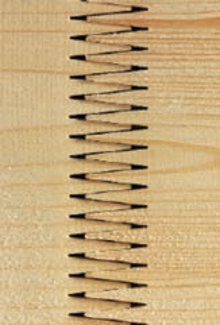Finger-jointed timber test results published
23 March 2013Encouraging test results have effectively cleared the way for finger-jointed timber to be used in metal-web joists.
However, the use of the material in trussed rafters still seems some way off, TRA members heard at the AGM.
The test results were shared for the first time at the AGM.
Initial impetus for wider use of finger-jointed structural timber came from timber suppliers Crown Timber, Vida and Stora Enso.
Subsequent testing by TRADA on finger-jointed timber used as chords in metal-web joists was "very favourable", according to TRA technical committee member Tony Fillingham.
However, he said further testing had been needed to test scenarios where the connector/splice plate was embedded in the finger-joint line. The TRA commissioned MiTek Industries to carry out this additional testing of finger-joints in tension to see if the connector plates affected the integrity of the finger-joint.
About 100 industrial tests were carried out using three different sources of finger-jointed stock (Crown, Vida and Stora Enso) used with 1mm, 1.25mm and 1.5mm connector plates embedded in the finger-joint line.
"The results were quite promising for most," said Mr Fillingham.
"As long as the price of finger-jointed timber is right, it means you could lose one splice plate and keep the price of the joist down and be a bit more competitive to sell more webs.
"But finger-joints in truss rafters is a completely different issue and there has been no testing."
Mr Fillingham said a greater range of testing was needed for finger-jointed timber in trussed rafters, including high stress connections and with girders. He said it was crucial that finger-joints performed in both bending and tension scenarios.
Crown Timber chief executive Stuart McIntyre told TTJ he believed there was scope for finger-jointed timber use in the trussed rafter sector, although the company was not currently actively pursuing promoting the material for that use.
He said the commercial proposition would also need to be looked at in detail.
Stora Enso Timber told TTJ that it thought finger-jointed timber could provide an option for truss rafter manufacturers in future.
"Stora Enso is very keen to be at the forefront of developing new products and solutions for customers," it said.
"How fast the finger-jointed timber market will develop and to what extent is hard to say. We don't see any significant shift in the next 12 months."
